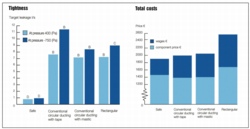Energy-efficient ductwork is a matter of class

Andy Watton believes the industry is too complacent about the energy penalties associated with the high rates of air leakage from ductwork systems.
Using less energy has become a national mantra. Every day we are urged to turn down the heating, turn off the lights, drive less and fly hardly at all
In this era of ‘green’ awareness it is hardly surprising that those responsible for designing our buildings are now hedged in by regulations designed to impose the strictest fuel parsimony; after all buildings account for around 40% of Britain’s energy bill.
And yet, in one respect at least, we are in danger of grasping savings firmly with one hand and throwing them away with the other.
Air is not free — at any rate not the air that circulates in the air-conditioning and ventilation systems serving our commercial and public sector buildings.
Those systems require fan power, and the UK’s relaxed attitude to ductwork leakage is wasting far too much of it.
Consulting engineers devote considerable effort and ingenuity to selecting air-handling plant with complex heat-recovery systems and fans with sophisticated EC/DC motors, proportional controls, inverter drives etc in a bid to ensure maximum energy efficiency.
Clever, and expensive, solutions all of them. But how often is duct leakage considered as part of the problem? For a true measure of the efficiency of any system the transfer losses need to taken into consideration; in a ventilation system, this means duct leakage.
The accepted rates of duct leakage are laid down in HVCA’s DW144 and range from class A to class C where C is the tightest leakage class — with a 9-fold reduction in leakage.
Applying a formula given in DW144 to a duct system of 150 m2 surface area, a volume flow of 2.5 m3/s and a pressure of 500 Pa gives permitted leakages rates of 229.5 l/s for a class A system and a leakage of just 25.5 l/s for a class C system.
As a result, to achieve the design requirement of a total of 2.5 m3/s of air arriving at the air terminal devices then, for a class A system, 2.73 m3/s would need to be input by the air-handling plant to compensate for losses, as opposed to just 2.53 m3/s for a class C system — an 8% increase!
Moreover, the fan laws also dictate that providing this additional air requires a further increase in fan power of around 13%.
What other branch of building services would tolerate wastage at these levels?
It gets worse. In addition to the additional energy consumed by the fan, energy used in generating heating and cooling is also wasted and is directly proportional to the leakage. Moving up from a class A system to a class C system would represent an additional saving of 8% of heating and cooling energy consumption.
While these figures must be considered purely as a guide, they clearly demonstrate the magnitude of savings potentially available — savings that simply cannot be ignored.

It has been calculated* that if all European ducting systems were truly airtight, we could achieve an annual energy saving of about 10 TWh or the equivalent of the annual output of three nuclear power plants!
That should give you an idea of the scale of the problem, but the irony is that it is a problem to which there is a solution.
The technology to achieve class C air leakage as an industry minimum standard for circular ductwork is already available, and at cost-effective prices, from several manufacturers.
Obviously I am most familiar with my own company’s product. However, there are others, each offering their own special features, but sharing the environmental benefits of being made from fully recyclable steel and requiring no sealant or tapes.
Lindab’s Safe System circular ductwork offers a class C system straight out of the bag; with the correct installation techniques class D can be achieved. Its double-lipped EPDM sealing system ensures an airtight fit every, time offering the designer peace of mind in the knowledge that duct leakage will be minimised, and little or no compromise on fan power levels will be required to overcome the losses of leaking ductwork. As a result energy-efficient fans can be just that, and the designer can sleep tight in the knowledge that he has one less thing to worry about, and the end user can reap the lifetime savings.
In addition to saving energy the Safe System requires no sealant or tapes, so no curing time is required. This means that the Safe system can be installed and pressure tested the same day — eliminating return visits to site, reducing costs and cutting out additional CO2 generating journeys. The health-and-safety issues associated with using solvent-based sealing products on site and the environmental impact of disposing of empty tubes are also alleviated.
There are other spin-off benefits too, including eye appeal. Many ductwork systems are left exposed, and the Safe System provides a more aesthetically pleasing and professional joint appearance than can be achieved with traditional tapes or sealant.
How many of us could pass a running tap without trying to turn it off? Air leakage is invisible and pretty much silent, but the cost in environmental terms is cold, hard fact. We have the technology to make ductwork virtually airtight. Let’s put it to work.
Andy Watton is a regional manager for air movement with Lindab.
*Energy saving potential in Europe, Duct leakage in European buildings: status and perspectives, Energy & Buildings 32 (2000), Carrie F.R. et al., pp 235-243, Elsevier.







